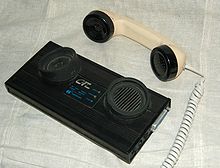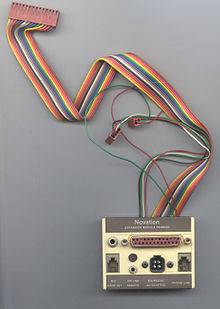- Novation CAT
-
Novation was an early modem manufacturer whose CAT series were popular in the early home computer market in the late 1970s and early 1980s, notably on the Apple II. The Hayes Smartmodem 300, introduced in 1981, helped kill off Novation and many other early modem companies over the next few years.
Contents
The Original CAT
Novation's first CAT was an external 300 bit/s Bell 103-standard modem that connected to the phone lines using an acoustic coupler. Like most other acoustically coupled modems, the CAT required the user to dial the desired number on a normal telephone, and then press the handset into rubber cups on the modem if a carrier could be heard. This was only possible because telephones were generally available only from Western Electric, all of a standardized size and layout. There was no sort of automated operation available; even hanging up had to be done manually (by depressing the handset hook on the base of the telephone).
The Apple-CAT II
Novation also introduced an internal direct-connect modem, the APPLE-CAT II, which plugged in to an expansion slot in an Apple II computer. Due to the internal connection, the APPLE-CAT II was able to feature a full range of dialing commands, and could report a wide range of call progress tones (BUSY, REORDER, etc.) that many modems still lack today. These operations were handled directly by software on the host computer; the modem set certain registers when tones were heard on the line, by timing when these registers were set or clear, the software could determine what was happening on the line.
The Apple-CAT II also supported the Bell 202 protocol, which allowed half-duplex 1200 bit/s operation when connecting to another Apple-CAT II modem. This was an exceptionally rare feature; modems with "full" 1200 bit/s operation were expensive devices intended to be used with minicomputers and mainframes, and typically cost thousands of dollars. Since the 1200 bit/s mode was half-duplex, or one-way only, the users would normally have to decide in advance which direction transmissions would proceed.
However, software was used to work around this limitation as well. File transfer programs written specifically for the Apple-CAT II's 202 mode, such as Catsend and the later CatFur, periodically paused and reversed transmission direction, so the receiving computer could acknowledge receipt of a stream of data, and, in the case of CatFur, could add a short chat message to the sender in the middle of the one-way file transfer. Many bulletin board systems (BBSs) running CatSend and then CatFur were set up to transfer warez. The 202 CatFur protocol could only be used by a user running another APPLE-CAT II.
In addition, the APPLE-CAT II had the ability to support CCITT v.21 and CCITT v.23. Though no known applications took advantage of this facility, it was possible to modify certain software such as ASCII Express by use of a hex editor to take advantage of this feature.
Novation also released a full-duplex Bell 212 (modem)-compatible expansion known as the Novation 212 Expansion Card, which plugged into the Apple II motherboard as well as an existing APPLE-CAT II via a ribbon cable. The card was very expensive, and rarely seen. Novation also created an 'Expansion Pack' or external breakout box that would connect to the large pin header on the top middle of the card. This item allowed easy external access to the built in serial port, phone line and hand set connections. Due to its cost at the time, the item is very rare.
The APPLE-CAT II was popular with phone phreakers for its high half-duplex 1200 bit/s speed and its ability to detect various tones. It also had the ability to generate tones directly into the phone line. Several specialized applications such as TSPS, The Cats Meow and Phantom Access were used to mimic standard telephone sounds such as standard numeric DTMF dial tones as well as blue box tones, ringing (both American and International), dial tones, call waiting alerts, busy signals, 2600 Hz tones, and other effects such as payphone sounds. Due to these and other features, the APPLE CAT II could be used as a black box, red box, hacking tool, answering machine, war dialer, voice simulator, voice distorter, etc.
Despite the APPLE-CAT II's popularity, its early years were faced with incompatibility with most telecommunications programs, as its native API is considered proprietary by today's standards. To increase compatibility without re-coding these programs, Novation released a firmware upgrade kit (an EPROM package) allowing the modem to emulate the Hayes Micromodem II, including the MMII's IN#x control codes. At the APPLE-CAT II's peak, compatibility with its native API increased, and MMII emulation became less of a necessity.
The EPROM and SSI75T201 Tone Receiver Option is available via the Apple II Legacy dealer ReactiveMicro.com.
The D-CAT
A direct-connect version of the original 300 bit/s external modem was later released as the D-CAT (D for direct). To operate the D-CAT, an external telephone was still required to dial. Once the connection was made, a button was pressed on the modem which made it "pick up" the phone, at which point the handset could be hung up. A further improvement was the Auto-CAT, which allowed dialing the phone by entering the number when the modem was first started. Once the connection was made the modem switched to "data mode", and from then on had to be operated manually.
The J-CAT
The J-CAT was Novation's first attempt to make a "smart modem", albeit in a rather non-standard fashion. Its most basic feature was that J-CAT could be placed in a mode where it would automatically pick up the phone if it was called, offering rudimentary auto-answer capability. In an era when it could be safely assumed that the remote user would hang up when they were finished their call, as they were likely using an acoustic coupler modem like the original CAT, the lack of a "hang up my phone" command was not a real problem. This made the J-CAT useful for BBS use; Novation ran a simple one to allow users to test their new modems.
The J-CAT also supported another non-standard feature that allowed direct control of the phone line. Instead of using in-band signalling, like the Smartmodem, the J-CAT passed the on/off-hook control, carrier detect and phone status indication to the computer through otherwise unused pins in the RS-232C connector. The computer could pulse the hook line to simulate pulse dialing or hang up, and read the status pin to look for line signals like ringing or busy (any noise on the line was reported as "1"). Using these features required a computer able to signal on spare pins, often requiring a second connector and a custom cable to support it. Combined with proper software this made the J-CAT fairly "smart", although Novation was careful to state it was not a "smart modem". Operation was generally similar to the APPLE-CAT in concept. Interestingly, the J-CAT was released after the Smartmodem 300, so, unsurprisingly, it was never very popular even though it was fairly low-cost (for the era).
The Smart-CAT 103 & Smart-CAT 103-212
Novation eventually introduced their own standard smart modems, the Smart-CAT 103 and Smart-CAT 103-212. As the names imply, the later included 1200 bit/s Bell 212 operation in addition to 300 bit/s Bell 103. The later was also offered as the 212 Apple-CAT II, as an internal modem. These models had little to distinguish themselves from other Smartmodem clones, and Novation appears to have disappeared in the early 1980s.
Notes
The original CAT was also sold by Atari as the Atari 830 Modem.
References
Categories:- Telecommunications equipment vendors
- Defunct computer companies of the United States
- Modems
- Apple II peripherals
- Defunct computer hardware companies
Wikimedia Foundation. 2010.



